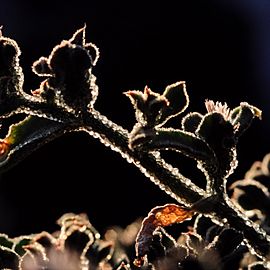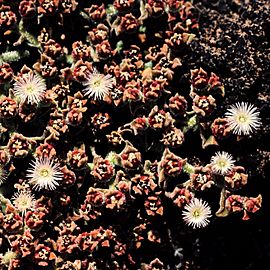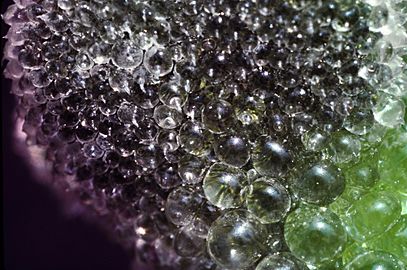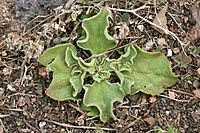Common iceplant facts for kids
Quick facts for kids Common iceplant |
|
|---|---|
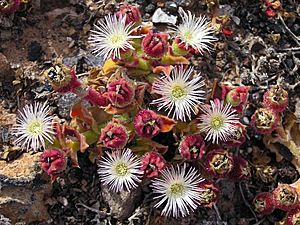 |
|
| Mesembryanthemum crystallinum flowering in Lanzarote | |
| Scientific classification | |
| Genus: |
Mesembryanthemum
|
| Species: |
crystallinum
|
| Synonyms | |
|
Cryophytum crystallinum (L.) N.E.Br. |
|
The Mesembryanthemum crystallinum is a unique plant often called the common ice plant or crystalline ice plant. It's a type of succulent plant, which means it has thick, fleshy parts that store water. This plant is covered with special cells that look like tiny, glistening water bubbles, making it appear as if it's covered in ice crystals.
It originally comes from Africa, the Sinai, and southern Europe. Over time, it has spread and now grows naturally in many parts of the New World, including North and South America.
Contents
What Does the Ice Plant Look Like?
The common ice plant has stems that spread out along the ground, growing about 20 to 60 centimeters long. Its leaves are usually between 2 and 10 centimeters long.
This plant blooms from March to October. Its flowers have many petals and are about 2.5 centimeters wide. They open in the morning when the sun is out and close at night. Insects help to pollinate these flowers.
The "ice" look comes from special enlarged cells on the plant's surface, called "bladder cells." These cells are super important because they help the plant store water, especially in dry places. The ice plant can live for one year, two years, or even longer, but it often finishes its life cycle in just a few months, depending on how much water and good conditions it gets.
How Does the Ice Plant Survive?
The ice plant has an amazing trick to survive in tough places. Usually, it makes its food using a common process called C3 carbon fixation. But if it doesn't get enough water or if the soil becomes very salty, it can switch to a different way of making food called Crassulacean acid metabolism. This switch helps it save water and deal with stress.
Like many plants that can grow in salty soil, the ice plant collects salt inside its body throughout its life. It stores the most salt in those special bladder cells on its leaves. When the plant eventually dies, this stored salt is released into the soil. This makes the soil too salty for many other plants to grow, but the ice plant's own seeds are tough enough to sprout in these salty conditions. This gives the ice plant a head start over other plants.
The number of seeds the plant produces depends on whether it had to switch to its special water-saving food-making process. The older parts of the plant dry out as it produces seeds, but the seed capsules keep collecting salt and make healthy seeds. Seeds from the top of the capsule usually sprout quickly, while those from the bottom might wait longer before growing.
Where Does the Ice Plant Grow?
The common ice plant is originally from Africa, the Sinai, and southern Europe. But it has spread and now grows naturally in the southwestern parts of North America, as well as in South America and Australia.
You can find it growing in many different types of soil, from sandy beaches and dunes to loamy and clay soils. It's very good at growing in poor or salty soils. It also likes to grow in disturbed areas, like along roadsides, in empty lots, or near old buildings.
Is the Ice Plant Invasive?
In some places like North America, South America, and Australia, the M. crystallinum is considered an invasive species. This means it can spread quickly and take over areas, sometimes harming native plants. Its ability to grow in poor or salty soils and its preference for disturbed areas are common traits of invasive plants.
Because it collects salt and then releases it into the soil when it dies, it creates an environment where other plants struggle to germinate (sprout). This allows the ice plant to grow in new areas with very little competition from other species. Farm animals usually don't eat the ice plant.
What is the Ice Plant Used For?
The leaves of the ice plant are edible, just like some other plants in the Aizoaceae family. In the past, people in the United States and Europe tried to promote it as a vegetable similar to spinach, but it didn't become very popular.
In southern Africa, people gather the leaves and stems from the wild and pickle them. In Japan, the ice plant has become a common vegetable sold in supermarkets. This happened after Saga University found a way to grow it in large amounts using hydroponic methods (growing plants in water without soil) in 2009. In Japan, it's known by names like ice plant (アイスプラント), salt leaf (ソルトリーフ), and barafu (バラフ). The seeds are also safe to eat.
Besides food, the crushed leaves of the ice plant can be used as a soap substitute. It also has some traditional medicinal uses. In South Africa, ice plants are sometimes planted in gardens to help prevent fires, a practice called "firescaping." It's also grown just for its beauty as an ornamental plant. Because it collects salt, the ice plant might even be useful for cleaning up polluted soil, a process called bioremediation.
Error: no page names specified (help). In Spanish: Mesembryanthemum crystallinum para niños
In Spanish: Mesembryanthemum crystallinum para niños


